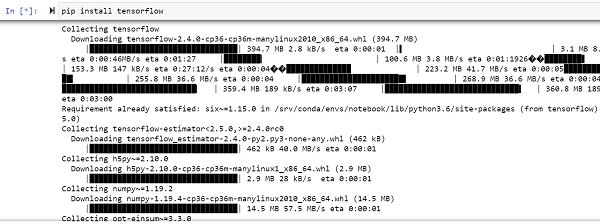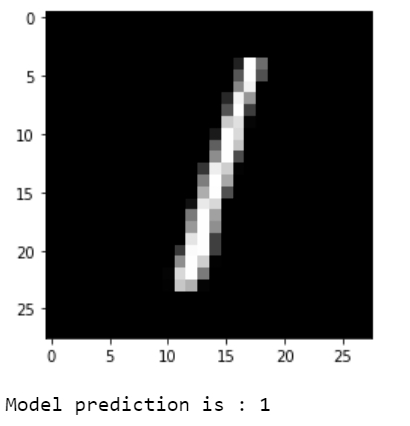
 Data Structure
Data Structure Networking
Networking RDBMS
RDBMS Operating System
Operating System Java
Java MS Excel
MS Excel iOS
iOS HTML
HTML CSS
CSS Android
Android Python
Python C Programming
C Programming C++
C++ C#
C# MongoDB
MongoDB MySQL
MySQL Javascript
Javascript PHP
PHP
- Selected Reading
- UPSC IAS Exams Notes
- Developer's Best Practices
- Questions and Answers
- Effective Resume Writing
- HR Interview Questions
- Computer Glossary
- Who is Who
How can Logistic Regression be implemented using TensorFlow?
Tensorflow is a machine learning framework that is provided by Google. It is an open-source framework used in conjunction with Python to implement algorithms, deep learning applications and much more. It is used in research and for production purposes. It has optimization techniques that help in performing complicated mathematical operations quickly. This is because it uses NumPy and multi-dimensional arrays.
Multi−dimensional arrays are also known as ‘tensors’. The framework supports working with deep neural network. It is highly scalable, and comes with many popular datasets. It uses GPU computation and automates the management of resources.
The ‘tensorflow’ package can be installed on Windows using the below line of code −
pip install tensorflow
Tensor is a data structure used in TensorFlow. It helps connect edges in a flow diagram. This flow diagram is known as the ‘Data flow graph’. Tensors are nothing but multidimensional array or a list.
The MNIST dataset contains handwritten digits, wherein 60000 of them are used for training the model and 10000 of them are used to test the trained model. These digits have been size−normalized and centered to fit a fixed-size image.

Following is an example −
Example
from __future__ import absolute_import, division, print_function
import tensorflow as tf
import numpy as np
num_classes = 10
num_features = 784
learning_rate = 0.01
training_steps = 1000
batch_size = 256
display_step = 50
from tensorflow.keras.datasets import mnist
(x_train, y_train), (x_test, y_test) = mnist.load_data()
x_train, x_test = np.array(x_train, np.float32), np.array(x_test, np.float32)
x_train, x_test = x_train.reshape([-1, num_features]), x_test.reshape([−1, num_features])
x_train, x_test = x_train / 255., x_test / 255.
train_data = tf.data.Dataset.from_tensor_slices((x_train, y_train))
train_data = train_data.repeat().shuffle(5000).batch(batch_size).prefetch(1)
A = tf.Variable(tf.ones([num_features, num_classes]), name="weight")
b = tf.Variable(tf.zeros([num_classes]), name="bias")
def logistic_reg(x):
return tf.nn.softmax(tf.matmul(x, A) + b)
def cross_entropy(y_pred, y_true):
y_true = tf.one_hot(y_true, depth=num_classes)
y_pred = tf.clip_by_value(y_pred, 1e−9, 1.)
return tf.reduce_mean(−tf.reduce_sum(y_true * tf.math.log(y_pred),1))
def accuracy_val(y_pred, y_true):
correct_prediction = tf.equal(tf.argmax(y_pred, 1), tf.cast(y_true, tf.int64))
return tf.reduce_mean(tf.cast(correct_prediction, tf.float32))
optimizer = tf.optimizers.SGD(learning_rate)
def run_optimization(x, y):
with tf.GradientTape() as g:
pred = logistic_reg(x)
loss = cross_entropy(pred, y)
gradients = g.gradient(loss, [A, b])
optimizer.apply_gradients(zip(gradients, [A, b]))
for step, (batch_x, batch_y) in enumerate(train_data.take(training_steps), 1):
run_optimization(batch_x, batch_y)
if step % display_step == 0:
pred = logistic_regression(batch_x)
loss = cross_entropy(pred, batch_y)
acc = accuracy_val(pred, batch_y)
print("step: %i, loss: %f, accuracy: %f" % (step, loss, acc))
pred = logistic_reg(x_test)
print("Test accuracy is : %f" % accuracy_val(pred, y_test))
import matplotlib.pyplot as plt
n_images = 4
test_images = x_test[:n_images]
predictions = logistic_reg(test_images)
for i in range(n_images):
plt.imshow(np.reshape(test_images[i], [28, 28]), cmap='gray')
plt.show()
print("Model prediction is : %i" % np.argmax(predictions.numpy()[i]))
Code credit &minus https://github.com/aymericdamien/TensorFlow-Examples/blob/master/tensorflow_v2/notebooks/2_BasicModels/logistic_regression.ipynb
Output
step: 50, loss: 2.301992, accuracy: 0.132812 step: 100, loss: 2.301754, accuracy: 0.125000 step: 150, loss: 2.303200, accuracy: 0.117188 step: 200, loss: 2.302409, accuracy: 0.117188 step: 250, loss: 2.303324, accuracy: 0.101562 step: 300, loss: 2.301391, accuracy: 0.113281 step: 350, loss: 2.299984, accuracy: 0.140625 step: 400, loss: 2.303896, accuracy: 0.093750 step: 450, loss: 2.303662, accuracy: 0.093750 step: 500, loss: 2.297976, accuracy: 0.148438 step: 550, loss: 2.300465, accuracy: 0.121094 step: 600, loss: 2.299437, accuracy: 0.140625 step: 650, loss: 2.299458, accuracy: 0.128906 step: 700, loss: 2.302172, accuracy: 0.117188 step: 750, loss: 2.306451, accuracy: 0.101562 step: 800, loss: 2.303451, accuracy: 0.109375 step: 850, loss: 2.303128, accuracy: 0.132812 step: 900, loss: 2.307874, accuracy: 0.089844 step: 950, loss: 2.309694, accuracy: 0.082031 step: 1000, loss: 2.302263, accuracy: 0.097656 Test accuracy is : 0.869700




Explanation
The required packages are imported and aliased.
The learning parameters of the MNIST dataset are defined.
The MNIST dataset is loaded from the source.
The dataset is split into training and testing dataset. The images in the dataset are flattened to be shown as a 1−d vector that has 28 x 28 = 784 features.
The image values are normalized to contain [0,1] instead of [0,255].
A function named ‘logistic_reg’ is defined that gives the softmax value of the input data. It normalizes the logits to contain a probability distribution.
The cross entropy loss function is defined, that encodes the label to a one hot vector. The prediction values are formatted to reduce the log(0) error.
The accuracy metric needs to be computed, hence a function is defined.
The stochastic gradient descent optimizer is defined.
A function for optimization is defined, that computes gradients and updates the value of weights and bias.
The data is trained for a specified number of steps.
The built model is tested on the validation set.
The predictions are visualized.

